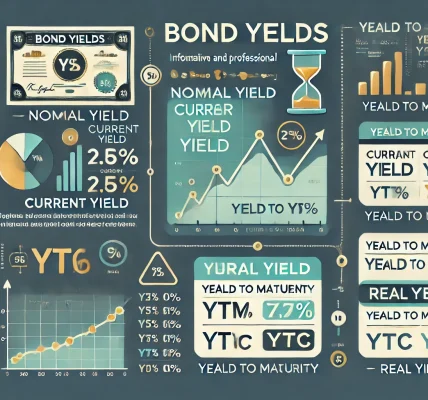Introduction
Investing in bonds is an excellent way for beginners to generate steady income, preserve capital, and diversify their portfolios. Bonds provide more stability than stocks and can be a great tool for achieving long-term financial goals. However, to maximize returns and minimize risks, beginners must understand the best bond investment strategies.
In this article, we will explore top bond investment strategies that every beginner should know. These strategies will help you make informed decisions and build a strong bond portfolio.
Understanding Bonds: The Basics
Bonds are fixed-income securities issued by governments, corporations, and municipalities to raise capital. When you invest in bonds, you lend money to the issuer in exchange for periodic interest payments and the return of your principal at maturity.
Types of Bonds
- Government Bonds – Issued by national governments (e.g., U.S. Treasury bonds, Indian Government Bonds).
- Municipal Bonds – Issued by local governments or municipalities.
- Corporate Bonds – Issued by companies to finance business activities.
- High-Yield (Junk) Bonds – Higher risk but offer higher returns.
- Inflation-Protected Bonds (TIPS) – Adjusted for inflation to preserve purchasing power.
Now that you understand the basics, let’s explore the top bond investment strategies.
1. Laddering Strategy
Bond laddering is a popular strategy where you invest in bonds with different maturities. This helps manage interest rate risks and ensures a steady stream of income.
How It Works
- Invest in short-term, medium-term, and long-term bonds.
- As shorter bonds mature, reinvest in new bonds with higher interest rates.
- Provides liquidity and reduces the risk of locking funds in low-interest-rate bonds.
Example:
- Buy a 1-year, 3-year, 5-year, and 10-year bond.
- When the 1-year bond matures, reinvest the proceeds into a new 10-year bond.
- This process continues, ensuring steady returns and mitigating interest rate risks.
2. Barbell Strategy
In this approach, you invest in both short-term and long-term bonds, avoiding intermediate-term bonds.
Benefits:
- Short-term bonds provide liquidity.
- Long-term bonds offer higher yields.
- Helps investors hedge against interest rate fluctuations.
Example:
- Invest 50% in 1-3 year bonds.
- Invest 50% in 10-30 year bonds.
- This strategy balances risk and return effectively.
3. Buy and Hold Strategy
Ideal for conservative investors, this strategy involves buying bonds and holding them until maturity.
Why It Works:
- Ensures a predictable income stream.
- Protects against market fluctuations.
- Eliminates the need for active trading.
Best For:
- Retirees seeking stable income.
- Investors who want low-risk returns.
4. Total Return Approach
Instead of relying solely on interest payments, this strategy focuses on capital appreciation and interest income.
How to Implement:
- Invest in undervalued bonds.
- Buy bonds during low-interest rate periods and sell when prices rise.
- Requires active portfolio management.
Best For:
- Investors looking for growth and income.
- Those willing to monitor bond markets actively.
5. Investing in Bond ETFs and Mutual Funds
For beginners who don’t want to manage individual bonds, Bond ETFs and Mutual Funds offer an easy way to invest in diversified bonds.
Advantages:
- Diversification – Reduces risk by investing in multiple bonds.
- Liquidity – Easy to buy and sell like stocks.
- Professional Management – Fund managers handle investments.
Best Bond ETFs and Mutual Funds:
- Vanguard Total Bond Market ETF (BND)
- iShares Core U.S. Aggregate Bond ETF (AGG)
- PIMCO Total Return Bond Fund
6. Tactical Bond Investing
This involves adjusting your bond portfolio based on economic trends and interest rate movements.
Tactics:
- Increase bond exposure when interest rates fall.
- Reduce bond holdings when interest rates rise.
- Invest in inflation-protected bonds (TIPS) during inflationary periods.
Best For:
- Investors who actively monitor economic indicators.
- Those comfortable with market timing.
7. Tax-Advantaged Bond Investing
Some bonds offer tax-free interest income, making them an excellent choice for investors in high tax brackets.
Types of Tax-Free Bonds:
- Municipal Bonds – Tax-exempt in many regions.
- U.S. Treasury Bonds – Exempt from state and local taxes.
Who Should Consider This?
- High-income individuals looking to reduce tax liabilities.
- Investors seeking secure, tax-efficient returns.
Choosing the Right Bond Strategy
Selecting the best bond strategy depends on your investment goals, risk tolerance, and time horizon.
Recommended Strategies Based on Investor Type:
| Investor Type | Best Strategy |
|---|---|
| Conservative (Low Risk) | Buy and Hold, Laddering |
| Moderate (Balanced Risk) | Barbell Strategy, Bond ETFs |
| Aggressive (Higher Returns) | Total Return Approach, Tactical Investing |
Conclusion
Bond investments offer a safe and stable way to grow wealth. By using strategies like laddering, buy-and-hold, tactical investing, and ETFs, beginners can build a strong bond portfolio that aligns with their financial goals.
Key Takeaways:
- Diversify with different bond types.
- Understand interest rate risks and how they affect bonds.
- Choose a strategy based on your investment goals.
- Consider bond ETFs for easy management.
By following these strategies, beginners can confidently navigate the bond market and create a reliable passive income stream.



